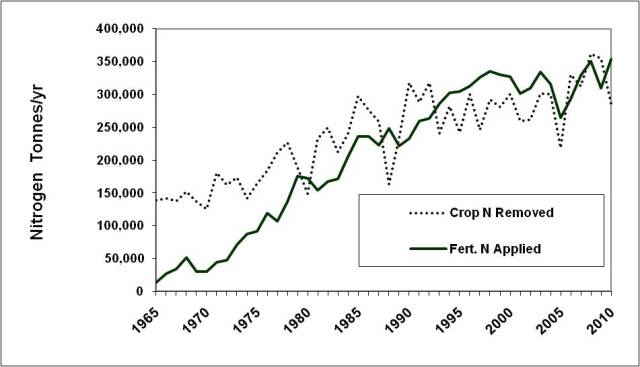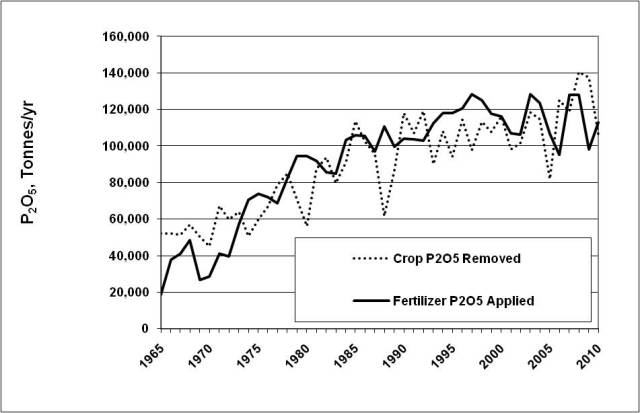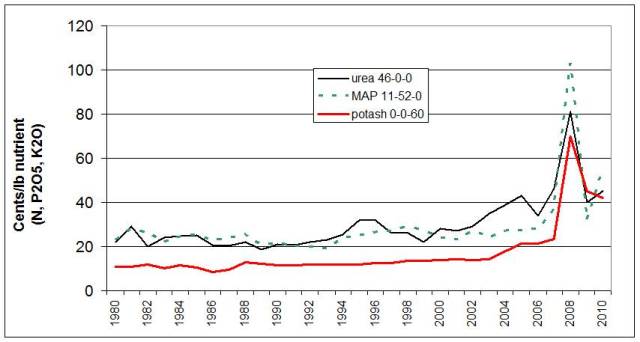Nutrient Balances in Manitoba
Prepared by John Heard, MB Ag Soil Fertility Specialist
Periodically it is beneficial to review the nutrient balance within the province as a whole, to see how fertilizer applications compare to crop removal.
The following figures illustrate the historic and recent fertilizer additions and crop removal values for nitrogen, phosphorus and potassium. The format for these charts was initially developed by Dr. Adrian Johnston (International Plant Nutrition Institute or IPNI) and is periodically updated by MB Ag staff. The information sources are Manitoba Agriculture, Food and Rural Development1 and crop nutrient removal values from the Canadian Fertilizer Institute2.

Figure 1. Fertilizer nitrogen applications and crop removal of nitrogen in Manitoba (Heard and Johnston, 2011)
It is apparent that prior to 1980 much more nitrogen was being removed from Manitoba soils than what was applied, much of which could be attributed to summer fallowing (Figure 1). Since that time the application of fertilizer and the nitrogen removed from crops appears much more balanced. In recent years the balance is occasionally negative, owing to high crop yields and modest fertilizer application rates due to higher fertilizer prices.

Figure 2. Fertilizer phosphorus applications and crop removal in Manitoba (Heard and Johnston, 2011)
As with nitrogen, the balance of phosphorus with crop removal was negative until the late 1970’s (Figure 2). Some surplus P was applied in the 1990’s but 3 of the past 5 years have seen removals exceeding the fertilizer applications.
Potassium removals have always outstripped applications in Manitoba (Figure 3).

Figure 3. Fertilizer potassium applications and crop removal in Manitoba (Heard and Johnston, 2011)
One of the major factors causing recent reductions in fertilizer usage has been the increase in fertilizer prices (Figure 4).

Figure 4. Average annual fertilizer prices in Manitoba (MAFRD).
The source of nutrients discussed here are only those fertilizer nutrients – other important sources must be considered:
Natural soil reserves – high soil organic matter supplied nitrogen and phosphorus for many decades through summer fallow practices. These reserves were largely depleted and almost all Manitoba cropland is continuously cropped now. Soil reserves still sustain much of the potassium needs of our crops. Potassium applications have never kept pace with removal in Manitoba with removal exceeding applications some 4 fold. Many of our soils are clay-based in texture with a high natural reserve of potassium. However over time we may see deficiencies appearing in high demand crops like forages, cereal and corn silage, potatoes and soybeans, especially on coarser-textured soils with lower potassium reserves.
Manure - if all excreted livestock manure were collected for application to crops, it would supply an estimated 7-8% of nitrogen requirements and about 15% of phosphorus requirements. The challenges in applying manure to efficiently supply nutrients are well known. Often the N:P:K ratio of manure does not match that of annual crop needs. Much manure is still applied “free-range” and defies collection for mechanical application.
Biological nitrogen fixation – legume crops do not require fertilizer N. In fact, the crop removals in Figure 1 include some 29,000 t N from pulse crops of peas and soybeans and some 74,000 t N from forages.
Summary
Annual efficiency of fertilizer nitrogen and phosphorus is generally only considered to be 40-60% and 30%, respectively. However when looking at longer-term trends we can see that additions rather closely match removals in this province. On a whole there is a closer balance of nitrogen and phosphorus additions and removals.
However these general trends are of little value to individual Manitoba growers and individual fields. Such fields demand specific attention in regards to their soil reserves and crop needs. That means soil testing and appropriate fertilization for profitable crop response and to sustain soil fertility levels.
References
1Manitoba Agriculture, Food and Rural Development. Knowledge Management. Industry Intelligence Section. http://www.gov.mb.ca/agriculture/market-prices-and-statistics/
2Nutrient uptake and removals – Western Canada. 2001. Canadian Fertilizer Institute http://www.cfi.ca/_documents/uploads/elibrary/d161_NU_W_01[1].pdf

